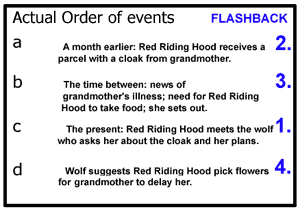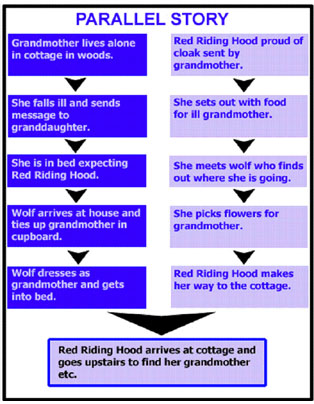Video Production
Structuring your Story
2.4 How Will You Structure Your Story?
When filmmaking was invented, there was no such thing as editing; the story of a journey covered the whole event from start to end. The story in your video does not need to be told in a linear order like this, you should use a structure which emphasises the most important aspects. In this chapter we will look at some different methods.
Basic Story Structuring
You should be able to relate your story in such a way that the most important bit is highlighted, usually placing it in the middle. The beginning and ending frame this, the beginning establishes the background and the end giving a sense of satisfaction and closure.
When we watch a film, documentary or TV programme we are often caught up in the story that it is telling and accept everything that happens on the screen as natural. In fact, everything that we see has been carefully chosen and arranged, on the screen and within the story, to have a specific effect on the audience. After seeing a programme we might tell a friend what it was about - we would tell the ‘story’ of what happens. But a programme or film is much more than just its story. The producers have constructed events to tell the story and told that story in a particular way.
Within the pattern of the story, time may be managed in various ways; events may be presented chronologically; there may be flashbacks or parallel story lines; parts of the story may be emphasised - more time may be given to some events or characters than to others. In constructing the plot, however, the project group must bear in mind what an audience can take in, given the length of the film/video and that the audience can’t ask for sections to be repeated if they get confused. (See narrative structure chart in the appendix, which may be useful to focus on how to tell your story).
So a narrative is a story told in a particular way. The same story could be told in different ways by different people: the way the story is told may depend upon the audience for which it is intended. There are a number of different techniques that can be used:

Figure 2.3: Flashback
Flashback
This is a common technique used to give perspective and interest to the structure of stories. This technique involves telling a story about the past with the film constantly jumping between the past and the present. The diagram below shows how the story of Little Red Riding Hood uses flashback. The numbers show the order in which the audience will see and find out about events, but the order in which they are listed, in letters, is the timeline in which events actually occur:
Parallel action

Figure 2.4: Parallel story.
This is where two events are shown at the same time, the audience assumes that they are happening simultaneously and will eventually come together.
Again, using the example of Little Red Riding Hood, the following diagram shows the timelines of the story of the two characters and the order in which they occur in relation to each other. This is, however, not necessarily the order in which events may be presented to the audience.
Viewpoint
An audience may feel like neutral observers watching a series of events unfold before their eyes, or they may identify strongly with a particular character. The position of the audience will depend on whose eyes the camera tells the story through. The placing of the camera can position the audience in relation to the characters on screen: the audience may be positioned as an onlooker as if in the centre stalls of a theatre watching events on stage; or the camera can bring the audience into the narrative space so that they see things from a particular perspective.
The Little Red Riding Hood story could be told through the eyes of Red Riding Hood, the eyes of the grandmother, or even through the eyes of the wolf. You may prefer, however, to present a detached viewpoint or the viewpoint of several characters. At this point your knowledge of your viewers is vital if you want make the audience you have chosen really understand your ideas. you will be able to decide at this point if and how to make them identify with the situation and hopefully be in sympathy with your story.
There are many factors then that shape a particular narrative. Films/videos may share a narrative pattern, but each will be different depending on its genre, the way it is made and the message the maker(s) wants to communicate. Every individual who sees the film will interpret it in a different way and have a different opinion about it depending on their personal experiences.